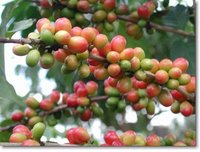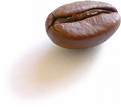Regardless of the brewing method there are a few prerequisites to brewing a great cup of coffee:
- Use high quality, freshly roasted coffee.
- Grind the beans just before brewing.
- Use clean brewing equipment.
- Ensue that your brewing equipment operates at the correct temperature.
- Use good quality water.
There are two basic methods of brewing coffee: espresso and infusion. All other methods are variations on these. The espresso method uses pressure to push superheated water through the coffee grounds. In the infusion method coffee grounds steep in water and release their soluble flavour molecules to brew the coffee.
Infusion
Infusion methods of brewing coffee are many and varied. They include French Press, perk pot, Brew 'n Touch, Vacuum Pot, Neapolitan Flip Pot, Turkish coffee, and most commonly, the automatic drip maker.
According to the Specialty Coffee Association of America (SCAA) infusion methods should ensure that the water is between 195 and 205 degrees Fahrenheit. Hotter and the delicate molecules are destroyed, cooler and the flavours are not leached properly from the grinds.
The SCAA also recommends that infusion should lasts for about 3 minutes. More than 3 minutes and coffee is over-extracted and becomes bitter. Less time and coffee is under-extracted and the coffee flavour is not able to develop in the brew.
Automatic drip coffee makers are the most common method of brewing coffee. With these coffee makers it is important to make sure that the water is hot enough and that the brewing cycle is neither to fast nor too slow. Many automatic drip coffee makers adequately meet these requirements, even inexpensive ones. Over time, though, scale builds on the heating elements and coffee residues build up in the basket and water head. The scale reduces the brewing temperature and the coffee residues go rancid making even fresh coffee taste bitter.
To prevent or reverse these problems, you can use a specially formulated coffee maker cleaner such as Cleancaf™. Try this before sending your coffee maker to the dump!
For best results try a permanent coffee filter. In recent years the fibres in coffee filter paper have become pressed very tightly in an effort to reduce production costs. This can result in the paper preventing some of the great flavours from passing through the filter. You should also use a grind that is somewhat coarse and not powdery. It requires a bit more coffee, but it is the best grind for this brewing method.
The French press is a method that allows the brewer more control over the brewing. Coffee is placed in a cylinder and hot water is added. The coffee steeps in the water and after a few minutes you use a fitted screen to press the coffee grounds to the bottom which separates them from the brewed coffee.
If you follow the SCAA guidelines this can be a great brewing method. You should wait a minute or two after boiling the water before adding it to the coffee grounds to let it cool to 205 degrees Fahrenheit and you should decant it after 3 minutes to end the extraction. You will also benefit from a consistent coarse coffee grind when using a French press.
An alternative to the French press is the new patented Brew 'n Touch. As with the French press, grounds and hot water are mixed in the infusion chamber. After about 3 minutes the brewer is placed on top of a cup which opens a valve that releases the brewed coffee into the cup.
Turkish coffee is brewed using extremely finely ground coffee in a specially designed stove top pot. The coffee and the water are placed together and set to boil. On boiling the coffee grounds sink and the coffee is brewed. There is no attempt to remove the grinds from the brew.
Espresso
Espresso makers come in many shapes and sizes from low cost stove top models to high end commercial models. Recently several manufacturers have introduced fully automatic espresso machines that grind the coffee, tamp the coffee, and brew it with the touch of a button.
Great espresso requires a very consistent finely ground coffee. This is required so that it can be consistently tamped down into the brewing head. This is very important because the water is forced through the grinds with pressure and if there are nooks and crannies for the water to flow through it will not brew correctly.
Once brewed, espresso coffee is used as the base for several familiar coffee drinks: latté, cappuccino, Americano to name a few. Latté mixes espresso with warm milk. Often milk will be steamed to heat it. Cappuccino mixes espresso with frothed milk. Steaming is used with a particular frothing technique to obtain cappuccino rather than latté. Americano is a shot of espresso with about 2 shots of hot water.
While the Americano may not sound very appetizing, it is actually our favourite coffee brewing method. We find that it accentuates the flavours of the coffee.
©Copyright 2003, 2004 Birds and Beans Inc. All rights reserved.

 According to legend an Arabian goatherd named Kaldi found his goats dancing joyously around a dark green leafed shrub with bright red cherries in the southern tip of the Arabian Peninsula. Kaldi soon determined that it was the bright red cherries on the shrub that were causing the peculiar euphoria and after trying the cherries himself, he learned of their powerful effect. The stimulating effect was then exploited by monks at a local monastery to stay awake during extended hours of prayer and distributed to other monasteries around the world. Coffee was born.
According to legend an Arabian goatherd named Kaldi found his goats dancing joyously around a dark green leafed shrub with bright red cherries in the southern tip of the Arabian Peninsula. Kaldi soon determined that it was the bright red cherries on the shrub that were causing the peculiar euphoria and after trying the cherries himself, he learned of their powerful effect. The stimulating effect was then exploited by monks at a local monastery to stay awake during extended hours of prayer and distributed to other monasteries around the world. Coffee was born. "Home brew coffee machines typically last three to five years, according to research conducted by Gevalia Kaffe, a purveyor of gourmet coffees. During that time, proper care and cleaning are critical to a good cup of coffee.
"Home brew coffee machines typically last three to five years, according to research conducted by Gevalia Kaffe, a purveyor of gourmet coffees. During that time, proper care and cleaning are critical to a good cup of coffee.



